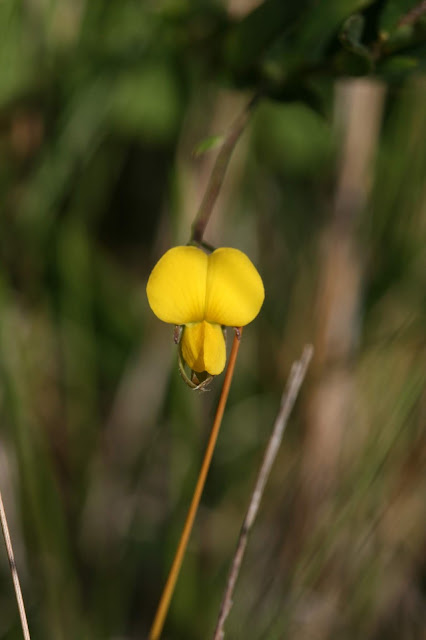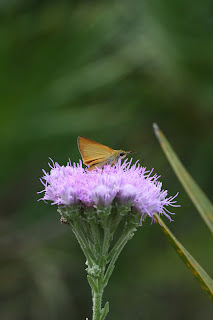Wednesday, December 26, 2018
Ipomoea purpurea - Tall Morning Glory
Florida is home to a great many native species of morning glories. The vast majority occur within the genus, Ipomoea and a few somewhat aggressive non-natives. As morning glories are much beloved landscape plants, some of the introduced species have wide distributions. Tall morning glory (Ipomoea purpurea) is one of those. I have not seen this species in "the wild", but it has been added to home landscapes in much of Florida. The photos above were taken of plants that I found growing on the north fence in the backyard of my new home in Pasco County. It has been vouchered growing in natural areas from only six counties distributed in north and central Florida, but I suspect it is more widely distributed than this. A check of the USDA database shows that it is reported as introduced in all but two of the Lower 48 states in North America and in Ontario and Quebec in Canada. I rarely have included non-native plants within this blog, but I have made an exception here for this species just to make clear that it is not a native Florida (or North American) species.
Tall morning glory is an apt common name for this species as it is an especially vigorous grower. The plants in my new backyard have spread into the upper canopy of all my neighbor's trees and across the vacant lot behind me on the ground. The first time that I mowed my new yard, I beheaded countless stems that had been rambling across it. Since that time, I have confined mostly to one fence and it provides about the only nectar/pollen in my landscape right now. It's value to that effect is shown in the top photo of a Southeastern blueberry bee.
Tall morning glory has beautiful sky blue flowers that are produced year round unless there is a hard freeze. It is extremely easy to grow and not especially fussy about growing conditions. It's heart-shaped leaves also are attractive , though the target of various small insect pests.
If you contemplate adding a morning glory to your fence, there are perhaps better, native, species that would be better choices.
Friday, December 14, 2018
Hairypod Cowpea - Vigna luteola
Hairypod cowpea, (Vigna luteola), is essentially found statewide, though it has not been vouchered in the Ocala/Lake Wales Ridge counties and a few in the Panhandle. This may well be an oversight as small, somewhat less-grandiose, species do not seem to be collected as avidly as the showier ones. Besides Florida, it is known throughout the Southeast Coastal Plain from Texas to Virginia and seems to also occur in Pennsylvania. Throughout this extended range, it is most common in mesic open sites.
Hairypod cowpea is a weak-stemmed vining perennial. Its many stems twine through the adjacent vegetation - it does not have tendrils. As it twines, it can partially smother the plants it climbs upon. Normally, its blooms rise an inch or two above the foliage. Both the leaflets and the bean-shaped seed pods are "hairy".
The flowers are bright canary yellow and quite attractive. Like most legumes, the lower petal is fused into a keeled lip and the petals above it are fused into "ears". Flowering can occur during most months, except winter in the northern half of the state.
Most twining legumes are difficult in a mixed wildflower planting because of their bad behavior and, thus, they are rarely propagated for the home landscape by native nurseries affiliated with FANN - the Florida Association of Native Nurseries. They tend to have value to the hardcore butterfly gardener, however, and should be made more available because of that. Hairy cowpea is a known larval host plant for the gray hairstreak, dorantes skipper, and long-tailed skipper. Although each of these butterflies also oviposits on other, less rambling species, adding hairy cowpea is useful to a butterfly garden where these three butterflies are to be considered. Finding plants from nurseries may be very difficult so look for the ripening beans during most months, harvest a few before they are completely dry and keep then in a closed paper bag until they split open. Such ripe pods burst open vigorously and you may actually hear them inside the paper bag. Sow the seed just below the soil surface and germination should occur within 2-3 weeks.
I have a few extra seed that I will share
I am mostly done planting seed for the 2019 season at Hawthorn Hill and I have a few seed left over of a very few species that I would share with you on a first come / first served basis. Let me know which species you are interest5ed in AND send me a SASE of sufficient size and with sufficient postage. The only catch is that the seed ONLY be used for your personal gardening efforts - NO COMMERCIAL use is warranted. I do not sell seed and I don;t expect you to make a profit off of it either....... Thanks
1. Chrysoma paucifoculosa - Woody goldenrod
2. Dalea pinnata - Summer farewell
3. Carphephorus corymbosus - Florida paintbrush
4 Liatris gracilis - Graceful blazing star
5.Liatris savannensis - Savanna blazing star
I have recently moved to Holiday, FL - which is just over the Pinellas border in Pasco County. I hope to have my annual Spring Sale in April or early May. I will post this when I set a date.
In the meantime, Merry Christmas / Happy Holidays to all of you.
Email me first about availability - huegelc55@aol.com
Then send your SASE to my new home address:
1648 Paragon PL
Holiday, FL 34690
Woody goldenrod
Graceful blazing star
Summer farewell
Florida paintbrush
1. Chrysoma paucifoculosa - Woody goldenrod
2. Dalea pinnata - Summer farewell
3. Carphephorus corymbosus - Florida paintbrush
4 Liatris gracilis - Graceful blazing star
5.Liatris savannensis - Savanna blazing star
I have recently moved to Holiday, FL - which is just over the Pinellas border in Pasco County. I hope to have my annual Spring Sale in April or early May. I will post this when I set a date.
In the meantime, Merry Christmas / Happy Holidays to all of you.
Email me first about availability - huegelc55@aol.com
Then send your SASE to my new home address:
1648 Paragon PL
Holiday, FL 34690
Woody goldenrod
Graceful blazing star
Summer farewell
Florida paintbrush
Subscribe to:
Comments (Atom)





 Savanna blazing star
Savanna blazing star


